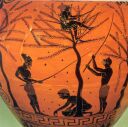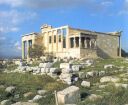|
Appreciating
Athena
Centaur and Olive Centaurs
return again and again to grace Athenian stories. Chiron, the wisest of
centaurs,
tutored Achilles. Lapiths and Centaurs featured on Parthenon metopes may
suggest the dangers of unrestrained animate passion. Feasting together
at a Lapith wedding, centaur guests honored for drawing humans into
fruitful natural interactions drink, dance, recollect worthy adventures.
One high-spirited centaur (among other guests) desires the worthy bride.
Seeing himself as superior to the groom, he carries her off,
initiating battles to come. Greeks, however, recognized
But the olive — cultivated, hardy, varied in uses — offers varied building materials for civic development, notably at Athens. The eagle, talons clutching arrows, represents the United States. The olive branch in the second talons recalls Athena. From this persistent, enduring, versatile root, Athens, its empire, and its influence grew. Athenians recall the competition between Poseidon and Athena for pre-eminence as patrons for a rustic but ambitious community. Poseidon struck the rock (acropolis) and salt water flowed, power manifested. Athena struck the rock and an olive sprouted, power suggested. Athenians anticipating Athena’s subtle crafts, follow her example.
Athena still awaits her votaries in the small temple just below the Athenian Parthenon, the Erectheion. Within the grand Parthenon, her statue in gold and ivory, towered forty-five feet above suppliants. But the Athena in the Erechtheion, just over human size, of gilded wood, appears before her olive, offering Athenians a share in her practices and accomplishments. Athenians made of her patronage a new civilization, the model or envy of the ancient world. The young
Odysseus formed his marriage bed on such olive column and roots, and from his
fruitful habitation with Penelope grew his family, his home and fields,
his kingdom, and his example for followers. Yearly visitors along
with Athenians joined the pan-Athenaic festival, tracing Athena’s influence
from the burial grounds of heroes, through the Dipylon Gate, past the
marketplace, up to the Acropolis. Just below the Parthenon, within
the Erechtheion, they offered her a freshly woven peplops (robe), her
fresh tunic
for the ensuing year. The caryatids
|




